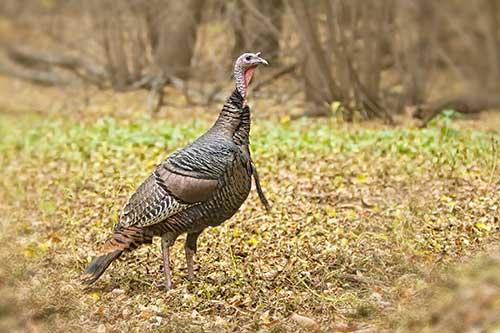Wild turkeys abound in nature
 Autumn is a wonderful time of year - it keeps a wildlife photographer and nature nut like myself very busy. I am really looking forward to spending some time with my family this coming Thanksgiving. So it makes perfect sense that at this time of year I can’t help but to think about wild turkeys.
Autumn is a wonderful time of year - it keeps a wildlife photographer and nature nut like myself very busy. I am really looking forward to spending some time with my family this coming Thanksgiving. So it makes perfect sense that at this time of year I can’t help but to think about wild turkeys.
The wild turkey (Meleagris gallopavo) is our largest native game bird in North America. This is the species from which our domestic white turkey was bred. It was not known to Europeans before coming to the Americas. This is uniquely an American bird, and it’s fitting that it is at the center of our yearly tradition of giving thanks for this great nation of ours.
Because it was such a plentiful and easy source for food, the turkey was nearly eliminated by over- hunting from many parts of the country early on in our history. In the 1930’s, this bird was close to extinction. But, thankfully, major efforts were made to reintroduce the turkey across the US, starting in the early 1960’s, with limited success. It wasn’t until the 1980’s when populations took hold and populations started to grow. There was an estimated 30,000 turkeys in the early 1900’s scattered throughout the US. Now, there is an estimated seven million birds, and growing. In fact, turkeys are now inhabiting areas thought not possible for these large birds in the past. It just goes to show you that given a chance, Mother Nature can do some amazing things.
There are five subspecies of turkey: Eastern (eastern half of country), Osceola (Florida), Rio Grande (Texas, Oklahoma, Kansas and Colorado), Merriam’s (western), and Gould’s (Mexico, and New Mexico and Arizona). They all have slightly different coloration, especially in the tail.
Turkeys have excellent vision, as most birds do. Color vision is important for all birds. This is why many birds are brightly colored. In the case of the turkey, not only are the feathers colored, so is the exposed skin on the head, especially the males. Individual adult birds have between 5,000 and 6,000 feathers covering their body. While they appear over-all brown, individual feathers have a metallic iridescence showing varying amounts of green, copper, bronze and gold, depending upon the intensity of the sunlight.
Sometimes, it may be difficult to distinguish males from females. The males are noticeably larger, and have a sharp spur on the back of their legs. Although the spurs may be hard to see from a distance, they are sharp, up to two inches long and curve downward. They use the spurs while fighting with other males during breeding season. The males also have a beard, which is a collection of long, thin feathers (filaments) resembling hair, clustered in the center of the breast and hang down like a beard. An adult male can have a beard up to a foot long, but most are only nine or ten inches. Interestingly, about 10-20 percent of hens also have a beard.
At this time of year, you see turkeys in self segregated groups, young males in one group, adult males in another. Females, young and old, stick together, along with the young from this past spring. The groups hang together until the breeding season in spring, when they will break up for nesting. I think we have a lot to be thankful for in this country, and our wild birds. Until next time...
Stan Tekiela is an author / naturalist and wildlife photographer who travels the world to study and photograph wildlife. He can be followed on www.facebook.com and twitter.com. He can be contacted via his web page at www.naturesmart.com.
